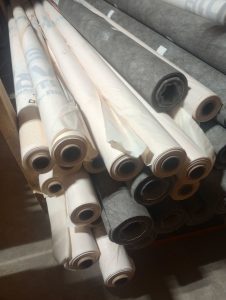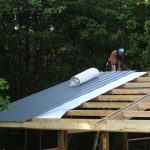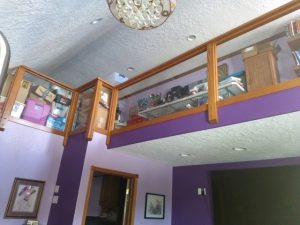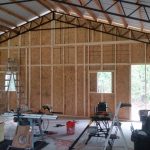To Vapor Barrier a Ceiling, or Not to Vapor Barrier a Ceiling.
Reader RAY in LAPINE writes:
“Hello, I live in Central Oregon, in climate zone #5. We are located in the High Desert at 4400 ft. The climate is dry with low humidity, occasional snow and cold in the winter. The summer temps are around 80 degrees, with large day to night temperature swings. Our heating hours per year are listed at approximately 7500+ per year. I am wanting to install 2×6 stringers, along with blow in insulation, but so many things are conflicting in my opinion, regarding my building when it comes to vapor barrier, no vapor barrier, heating hours per year, ventilation, etc., so I need your professional opinion. I have a 24×48 Pole barn, with double trusses, rated for 7 pound on the bottom cord. The truss bottoms are at 16ft off the concrete floor and are spaced 12 feet on center. The metal roof panels have dripstop that was factory installed. The walls have house wrap, behind bookshelf girts and was installed when the building was erected. The building has a continuous vented ridge, no soffit vents and is heated using a new, large, catalytic wood stove. I want to heat the building approximately 5-10 days a month, 8 to 10 hours a day for approximately 4 months of the year. So my question is, because of the drip stop panel coating and local heating hours, do I need any form of vapor barrier at the ceiling level or on the face of the purlins to avoid condensation issues??? I was originally going to install 10 mil, fire retardant, mesh reinforced poly on the bottom of the 2×6 stringers/trusses, wall to wall and blow insulation on top of the poly, then install 1/2 plywood painted white. Then I read not to use poly or a vapor barrier under 8000 heating hrs. After reading that, I thought I would use a air permeable product like ADO Insulweb, attached it to the bottom of the 2×6 stringers/trusses and blow insulation on top of that to R38, then install the plywood as stated before. Based on what I’ve read, it sounds like I need to install gable vents to the recommended ventilation ratio. Please provide me with your input and advice. Thank you.”
 Spent many a winter day on Mount Bachelor’s slopes back when I lived in Oregon (even 4th of July one year), so am familiar with your turf (my step-brothers also live in your immediate area).
Spent many a winter day on Mount Bachelor’s slopes back when I lived in Oregon (even 4th of July one year), so am familiar with your turf (my step-brothers also live in your immediate area).
Based upon your information, I would install ceiling plywood and then blow in insulation directly on top of it. Paint your plywood after it is installed and this should be a sufficient vapor retarder. You will need to add gable vents, in lower half of your attic space. For a 24′ x 48′ building, you will need at least 139 square inches of NFVA (net free ventilating area) in each endwall, in order to provide sufficient air intake. This may require more than a single vent in each end.
 DEAR THOMAS: In most instances eave and ridge vents are inadequate alone to prevent condensation. Contractors who fail to include some sort of thermal break between roof framing and roof steel are doing a severe disservice, in my opinion. It is so easy to accomplish at time of construction with products such as a Reflective Radiant Barrier or Integral Condensation Control. There is not a good option for an underside of purlins vapor barrier, as it is nearly impossible to adequately seal it. Your only real solution, at this point, would be to use two inches of closed cell spray foam on underside of your roof steel.
DEAR THOMAS: In most instances eave and ridge vents are inadequate alone to prevent condensation. Contractors who fail to include some sort of thermal break between roof framing and roof steel are doing a severe disservice, in my opinion. It is so easy to accomplish at time of construction with products such as a Reflective Radiant Barrier or Integral Condensation Control. There is not a good option for an underside of purlins vapor barrier, as it is nearly impossible to adequately seal it. Your only real solution, at this point, would be to use two inches of closed cell spray foam on underside of your roof steel. DEAR POLE BARN GURU:
DEAR POLE BARN GURU:  DEAR POLE BARN GURU:
DEAR POLE BARN GURU: 





